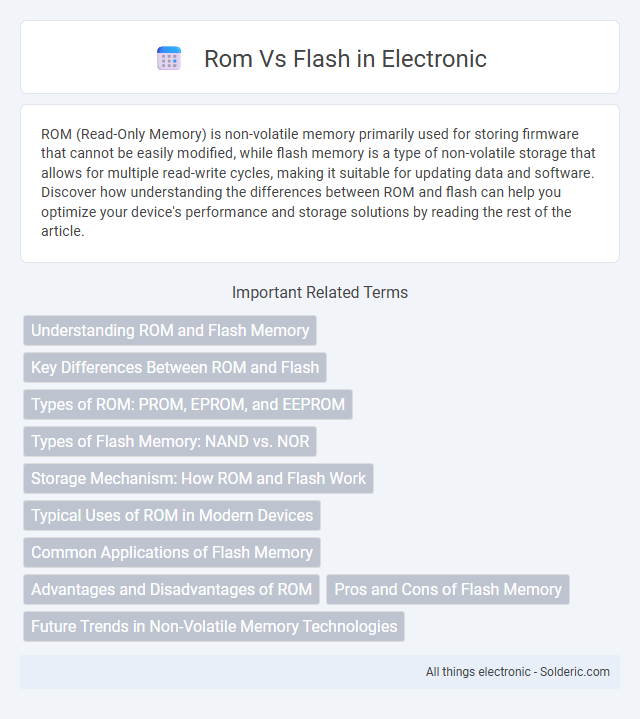ROM (Read-Only Memory) is non-volatile memory primarily used for storing firmware that cannot be easily modified, while flash memory is a type of non-volatile storage that allows for multiple read-write cycles, making it suitable for updating data and software. Discover how understanding the differences between ROM and flash can help you optimize your device's performance and storage solutions by reading the rest of the article.
Comparison Table
| Feature | ROM (Read-Only Memory) | Flash Memory |
|---|---|---|
| Definition | Non-volatile memory storing firmware permanently. | Non-volatile memory that can be electrically erased and reprogrammed. |
| Data Retention | Long-term, permanent storage. | Long-term storage; supports rewriting. |
| Reprogramming | Not reprogrammable or limited to factory programming. | Can be erased and rewritten multiple times. |
| Speed | Faster read speeds. | Moderate read/write speeds. |
| Use Cases | Firmware storage, boot loaders. | USB drives, SSDs, firmware updates. |
| Physical Structure | Mask programmed during manufacturing. | Uses floating-gate transistors for data storage. |
| Cost | Lower cost per unit for mass production. | Higher cost due to rewritability and complexity. |
Understanding ROM and Flash Memory
ROM (Read-Only Memory) is non-volatile storage designed to permanently hold firmware and essential system instructions, ensuring data retention without power. Flash memory, a type of EEPROM, offers rewritable storage with faster erase and write cycles, making it ideal for updates and data storage in devices like SSDs and USB drives. Understanding the differences in write capabilities, speed, and application areas between ROM and flash memory is crucial for optimizing device performance and longevity.
Key Differences Between ROM and Flash
ROM (Read-Only Memory) is non-volatile memory permanently programmed during manufacturing, making it ideal for storing firmware that does not require modifications. Flash memory, also non-volatile, allows electrical erasing and reprogramming, enabling your devices to update software or store data dynamically. The key differences lie in flexibility, with ROM fixed and Flash offering rewritable storage for evolving applications.
Types of ROM: PROM, EPROM, and EEPROM
Types of ROM include PROM (Programmable Read-Only Memory), which can be written once after manufacturing, EPROM (Erasable Programmable Read-Only Memory), allowing data to be erased with UV light and reprogrammed, and EEPROM (Electrically Erasable Programmable Read-Only Memory), which enables electrical erasure and rewriting of data multiple times. Flash memory, a type of EEPROM, supports faster erasing and programming, making it ideal for your frequent updates and storage solutions. Understanding these ROM types helps optimize data retention and memory performance in embedded systems and electronic devices.
Types of Flash Memory: NAND vs. NOR
NAND flash memory offers higher storage density and faster write/erase speeds, making it ideal for data storage applications like SSDs and USB drives. NOR flash provides faster read speeds and random access capability, often used in embedded systems for code execution. Understanding the differences between NAND and NOR flash helps optimize your choice for specific performance and durability requirements.
Storage Mechanism: How ROM and Flash Work
ROM (Read-Only Memory) stores data permanently through a process of physically encoding information during manufacturing, making its contents non-volatile and unchangeable under normal operation. Flash memory utilizes floating-gate transistors to trap electrons, enabling electrical erasure and reprogramming of data while maintaining non-volatile storage. The key difference lies in ROM's static, hard-coded data storage versus Flash's electrically erasable and rewritable mechanism, supporting dynamic data updates in modern devices.
Typical Uses of ROM in Modern Devices
ROM (Read-Only Memory) in modern devices typically stores firmware, such as the BIOS in computers or embedded software in smartphones and appliances, ensuring essential code remains intact and unaltered. It enables reliable boot processes and system initialization, critical for device stability and security. Your device depends on ROM to retain these permanent instructions even when powered off.
Common Applications of Flash Memory
Flash memory is widely used in portable electronic devices such as smartphones, tablets, and USB drives due to its fast read/write speeds and non-volatile storage capabilities. It serves as primary storage in solid-state drives (SSDs), offering enhanced durability and performance over traditional ROM. Flash memory is also essential in embedded systems, digital cameras, and memory cards, providing flexible and rewritable data storage options.
Advantages and Disadvantages of ROM
ROM (Read-Only Memory) offers non-volatile storage, preserving data without power and providing fast, reliable access essential for firmware and system boot processes. However, ROM's primary disadvantage is its immutability--once data is written during manufacturing, it cannot be modified or updated, limiting flexibility. Your choice of ROM is ideal for stable, unchanging code but less suitable for applications requiring frequent updates or customization.
Pros and Cons of Flash Memory
Flash memory offers fast read and write speeds, making it ideal for data storage in smartphones, USB drives, and SSDs. Its non-volatile nature ensures data retention without power, but it has a limited number of write/erase cycles compared to ROM, potentially reducing lifespan over time. Your choice between ROM and flash depends on whether you prioritize durability and permanence, as ROM is fixed and more stable, while flash provides flexibility and rewritable storage.
Future Trends in Non-Volatile Memory Technologies
Emerging non-volatile memory technologies like Resistive RAM (ReRAM) and Phase-Change Memory (PCM) are poised to surpass traditional ROM and flash by offering faster write speeds, higher endurance, and lower power consumption. Flash memory, while dominant in consumer electronics, faces scaling challenges and limited write cycles, driving research towards alternative solutions that combine the permanence of ROM with the flexibility of flash. The advancement of 3D stacking and novel materials will accelerate the adoption of these next-generation memories, enabling enhanced performance for AI, edge computing, and IoT devices.
rom vs flash Infographic

 solderic.com
solderic.com